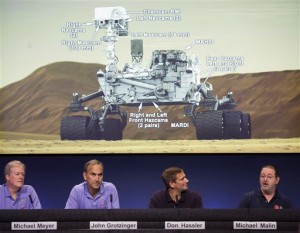Are we alone? NASA’s Mars rover aims to find out

Scientists comment on the seven cameras aboard the Curiosity Mars Rover, background, during a media briefing of the Mars Science Laboratory at NASA’s Jet Propulsion Laboratory, in Pasadena, California, Thursday, Aug. 2, 2012. From left: Michael Meyer, scientist, Mars Exploration Program lead; John Grotzinger, MSL project scientist, California Institute of Technology; Don Hassler, principal investigator, Radiation Assessment Detector on MSL; Michael Malin, principal investigator, Mars Descent Imager on MSL. Curiosity is scheduled to land on Mars at 1:31 a.m. Eastern time (0531 GMT) on Monday. AP PHOTO/DAMIAN DOVARGANES
WASHINGTON—Are we alone? Or was there life on another planet? NASA’s $2.5 billion dream machine, the Mars Science Laboratory, aims to take the first steps toward finding out when it nears Mars’s surface on Monday.
The planet is Earth’s closest neighbor, and scientists have found signs of water there, hinting that some form of life was once likely, even though Mars is now a dry place with a thin atmosphere, extreme winters and dust storms.
NASA said it will find out if its Mars Science Laboratory and rover, Curiosity – designed to hunt for soil-based signatures of life and send back data to prepare for a future human mission – landed safely at 1:31 a.m. Eastern time (0531 GMT) on Monday.
That will be about 14 minutes after the touchdown actually happens due to the time it takes for spacecraft signals to travel from Mars to Earth.
As of late Saturday, the laboratory was approximately 261,000 miles (420,039 kilometers) from Mars, closing in at around 8,000 miles per hour (13,000 kilometers per hour).
Article continues after this advertisement“Curiosity remains in good health with all systems operating as expected,” NASA said in a statement.
Article continues after this advertisementThe nuclear-powered rover is the biggest ever built for planetary exploration, weighing in at one ton, about the size of a small car, and carries a complex chemistry kit to zap rocks, drill soil and test for radiation.
The landing is a daring and unprecedented maneuver that involves penetrating the atmosphere at a speed of 13,200 miles per hour (21,240 kilometers per hour), slowing down with the help of a supersonic parachute and dropping down gently with tethers from a rocket-powered sky crane.
“This is the most challenging landing we have ever attempted,” said Doug McCuistion, director of NASA’s Mars Exploration Program.
Two NASA orbiters will be crossing overhead as the lander approaches the surface, and a third orbiter operated by the European Space Agency will also send data back to Earth.
The Mars Science Laboratory began its journey to the Red Planet more than eight months ago when it launched from the Florida coast in late November 2011.
“It gets scarier every day,” said McCuistion, noting that only about 40 percent of past attempts by global space agencies to send spacecraft to Mars have succeeded.
“Can we do this? Yeah, I think we can do this. I am confident the team has done an amazing job. We have the A-plus team on this. They have done everything possible to ensure success,” he said.
“But that risk still exists. It is going to be tough.”
NASA has detailed the final minutes of the complex landing in an Internet video called “Seven Minutes of Terror.” A live broadcast from mission control in Pasadena, California, will be on www.nasa.gov beginning at 0330 GMT Monday.
The landing site for the rover is a flat area known as Gale Crater, which lies near a mountain that scientists hope the rover will be able to climb in the search for sediment layers that could be up to a billion years old.
One potential factor of concern, the weather, appears to be cooperating after a nearby dust storm spotted days ago dissipated, deputy project scientist Ashwin Vasavada told reporters.
“Mars is playing nice and we are going to get good conditions for Sunday,” he said.
Vasavada said the dust storm near the landing site has evolved into a “fairly harmless cloud of dust” that probably will not reach Gale Crater by the time of the landing.
He said it was not “expected to affect entry, descent and landing in any meaningful way.”
If the landing goes according to plan, NASA hopes to have some low-resolution black and white images taken from cameras on the rear of the rover shortly afterward.
More images will follow in the coming days. Then, engineers on Earth will spend most of August remotely checking out systems on the vehicle, according to deputy program manager Richard Cook.
The rover is carrying a chemistry kit that contains a rock-zapping laser, 17 cameras, a drill, radiation detectors, water sensors, and tools to scoop soil and check for carbon-based compounds that are the building blocks for life.
Curiosity may start to roll for its first drive in September, with its first scoop samples expected late in the month and its first drilling attempt in October or November.
If the landing fails, McCuistion vowed that NASA would continue its efforts to explore Mars.
“We will pick ourselves up and dust ourselves off. We will look at this and do something again. We will do it again, this will not be the end,” he said.
“Human spirit gets driven by these kinds of challenges and these are the kinds of challenges that force us, drive us to explore.
“To explore our surroundings, to understand what is out there, and obviously look at ‘Are we alone?'”